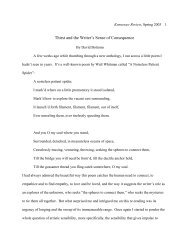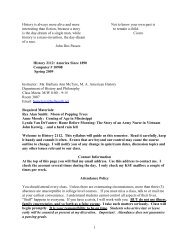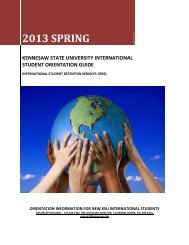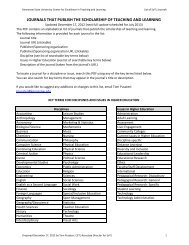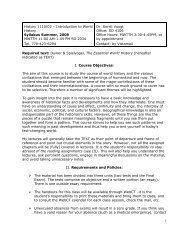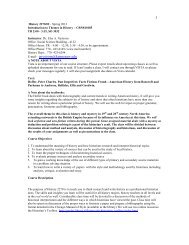Food, Gender and Cultural Hegemony - Kennesaw State University
Food, Gender and Cultural Hegemony - Kennesaw State University
Food, Gender and Cultural Hegemony - Kennesaw State University
You also want an ePaper? Increase the reach of your titles
YUMPU automatically turns print PDFs into web optimized ePapers that Google loves.
Cualli 140<br />
In the next phase (1550-1640) a pattern emerges in which a variety of<br />
foods similar to those common to the other culture were accepted. For example,<br />
peppers, squash, beans, a New World onion, <strong>and</strong> chiles were incorporated into a<br />
Spanish stew (to substitute cabbage, turnips, <strong>and</strong> European spices.) By 1600 the<br />
Spaniards had been able to produce wheat <strong>and</strong> other European vegetables in the<br />
New World so there was a broader range of culinary choices. The Spanish form of<br />
cooking, types of dishes, <strong>and</strong> seasoning were maintained as much as possible. Poor<br />
Spaniards (of which there were many) tended to consume indigenous foods for<br />
reasons of economy.<br />
In the third period (1640-1770) dishes appear that exhibit more<br />
characteristics of hybridity between the two cultures. The indigenous seasonings<br />
(especially various kinds of chile) became prominent in Spanish Creole cooking.<br />
Tomatoes (originally feared to be poison) began to be accepted. Chocolate was<br />
modified with sugar <strong>and</strong> vanilla, <strong>and</strong> served hot, to become a prized dessert drink.<br />
After extraordinary efforts by the Spanish, <strong>and</strong> repeated failures, grapes <strong>and</strong> olives<br />
had been successfully introduced to the New World, making a "civilized life" (by<br />
Spanish st<strong>and</strong>ards) finally possible (Crosby 71-73).<br />
Another important element of the analysis relates to the question of "high<br />
<strong>and</strong> low cuisine." Pierre Bourdieu refers to the differences in consumption of the<br />
high <strong>and</strong> the low as the opposition between "the tastes of luxury (or freedom) <strong>and</strong><br />
the tastes of necessity….Thus it is possible to deduce popular tastes for the foods<br />
that are simultaneously most 'filling' <strong>and</strong> most economical…The idea of taste,<br />
typically bourgeois, since it presupposes absolute freedom of choice, is so closely<br />
associated with the idea of freedom that many people find it hard to grasp the<br />
paradoxes of the taste of necessity….[they fail] to realize that necessity can only<br />
be fulfilled, most of the time, because the agents are inclined to fulfil it, because<br />
they have a taste for what they are anyway condemned to," (Bourdieu 177-78). In<br />
part this reasoning relates to an argument Bourdieu makes earlier that "foods<br />
probably constitute the strongest <strong>and</strong> most indelible mark of infant learning,"<br />
leading to sustained nostalgia <strong>and</strong> thus an innate yearning for the food of early<br />
[Type text]



